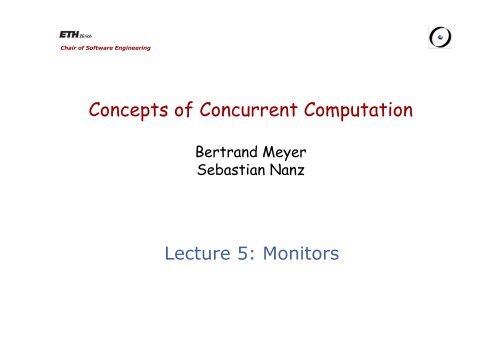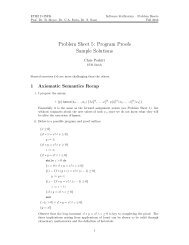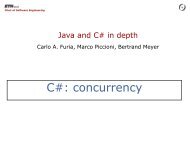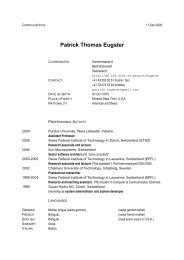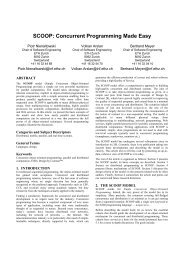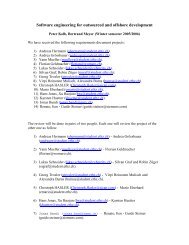Signaling disciplines - Chair of Software Engineering
Signaling disciplines - Chair of Software Engineering
Signaling disciplines - Chair of Software Engineering
Create successful ePaper yourself
Turn your PDF publications into a flip-book with our unique Google optimized e-Paper software.
<strong>Chair</strong> <strong>of</strong> S<strong>of</strong>tware <strong>Engineering</strong><br />
Concepts <strong>of</strong> Concurrent Computation<br />
Bertrand Meyer<br />
Sebastian Nanz<br />
Lecture 5: Monitors
Today's lecture<br />
In this lecture you will learn about:<br />
• the type <strong>of</strong> monitors, an important synchronization<br />
mechanism that separates the issues <strong>of</strong> mutual exclusion<br />
and condition synchronization,<br />
• implementation variants <strong>of</strong> monitors, in particular various<br />
signaling <strong>disciplines</strong>,<br />
• uses <strong>of</strong> monitors, in particular the readers-writers<br />
problem and the sleeping barber problem.<br />
2
<strong>Chair</strong> <strong>of</strong> S<strong>of</strong>tware <strong>Engineering</strong><br />
The monitor type
Why semaphores are not good enough<br />
• We have seen that semaphores provide a simple yet<br />
powerful synchronization primitive: they are conceptually<br />
simple, efficient, and versatile<br />
• However, one can argue that semaphores provide "too<br />
much" flexibility:<br />
• We cannot determine the correct use <strong>of</strong> a<br />
semaphore from the piece <strong>of</strong> code where it occurs;<br />
potentially the whole program need be considered<br />
• Forgetting or misplacing a down or up operation<br />
compromises correctness<br />
• It is easy to introduce deadlocks into programs<br />
• We would like an approach that supports programmers<br />
better in these respects, enabling them to apply<br />
synchronization in a more structured manner<br />
4
Monitors<br />
• Monitors are an approach to providing synchronization<br />
that is based in object-oriented principles, especially the<br />
notions <strong>of</strong> class and encapsulation<br />
• A monitor class fulfills the following conditions:<br />
• All its attributes are private<br />
• Its routines execute with mutual exclusion<br />
• A monitor is an object instantiating a monitor class<br />
• Intuition:<br />
• Attributes correspond to shared variables, i.e.<br />
threads can only access them via the monitor<br />
• Routine bodies correspond to critical sections, as at<br />
most one routine is active inside a monitor at any<br />
time<br />
5
Notation<br />
monitor class MONITOR_NAME<br />
feature<br />
end<br />
−− attribute declarations<br />
a1 : TYPE1 . . .<br />
−− routine declarations<br />
r 1 (arg 1 , ..., arg k ) do ... end<br />
. . .<br />
invariant<br />
−− monitor invariant<br />
6
Ensuring mutual exclusion in monitors (1)<br />
• The condition that at most one routine is active inside a<br />
monitor at any time is ensured by the implementation <strong>of</strong><br />
monitors (not burdened on the programmer)<br />
• We show an implementation based on semaphores – other<br />
implementation variants exist<br />
• With every monitor, associate a strong semaphore as the<br />
monitor's lock:<br />
entry : SEMAPHORE<br />
7
Ensuring mutual exclusion in monitors (2)<br />
• The semaphore entry is initialized to 1<br />
• Any monitor routine must acquire the semaphore before<br />
executing its body:<br />
r (arg 1 , ..., arg k )<br />
do<br />
entry.down<br />
body r<br />
entry.up<br />
end<br />
• The process queue entry.blocked <strong>of</strong> the semaphore entry<br />
is also called the entry queue <strong>of</strong> the monitor<br />
8
Solution to the mutual exclusion problem (1)<br />
monitor class CS<br />
feature<br />
end<br />
x_1 : TYPE 1 . . . x_m : TYPE m −− shared data<br />
critical_1<br />
do<br />
critical section 1<br />
end<br />
. . .<br />
critical_n<br />
do<br />
critical sectionn end<br />
9
Solution to the mutual exclusion problem (2)<br />
• As shown on the previous slide, the critical sections <strong>of</strong><br />
the n threads are taken as the bodies <strong>of</strong> routines<br />
critical_1, ..., critical_n<br />
• Then the mutual exclusion problem is solved as<br />
create cs.make<br />
P i<br />
1<br />
2<br />
3<br />
4<br />
while true loop<br />
cs.critical_i<br />
non-critical section<br />
end<br />
where cs is an instance <strong>of</strong> the monitor class CS<br />
• Mutual exclusion and starvation freedom follow from the<br />
properties <strong>of</strong> a strong semaphore<br />
10
Condition variables (1)<br />
• We have seen how monitors can provide mutual exclusion<br />
• What about other forms <strong>of</strong> synchronization, e.g.<br />
condition synchronization?<br />
• For this monitors <strong>of</strong>fer condition variables, which can be<br />
compared to semaphores as used for condition<br />
synchronization<br />
• However, their semantics is much different from<br />
semaphores and deeply intertwined with the monitor<br />
concept<br />
11
Condition variables (2)<br />
• A condition variable consists <strong>of</strong> a queue blocked and<br />
three (atomic) operations:<br />
• wait releases the lock on the monitor, blocks the<br />
executing thread and appends it to blocked<br />
• signal has no effect if blocked is empty; otherwise it<br />
unblocks a thread, but can have other side effects<br />
that depend on the signaling discipline used<br />
• is_empty returns true if blocked is empty, false<br />
otherwise<br />
• The operations wait and signal can only be called from<br />
the body <strong>of</strong> a monitor routine<br />
12
The sleeping barber problem (1)<br />
• A barbershop has n chairs for waiting customers and the<br />
barber’s chair. Rules <strong>of</strong> the barbershop:<br />
• If there are no customers waiting to be served, the<br />
barber goes to sleep<br />
• If a customer enters the barbershop and finds the<br />
barber sleeping, the customer wakes up the barber<br />
and then gets a haircut<br />
• If the barber is busy but there are waiting chairs<br />
available, the customer sits in one <strong>of</strong> the free chairs<br />
until called to the barber’s chair by the barber<br />
• If all chairs are occupied, then the customer leaves<br />
the shop<br />
• The problem consists in finding a starvation-free<br />
algorithm that observes these rules<br />
13
The sleeping barber problem (2)<br />
• Motivation: client-server relationships between<br />
operating system processes<br />
• Generalization <strong>of</strong> a barrier:<br />
• two parties must arrive before any can proceed<br />
• however the second party is not predetermined: the<br />
barber can serve any customer<br />
14
Monitor solution to the sleeping barber problem<br />
monitor class SLEEPING_BARBER<br />
feature<br />
num_free_chairs : INTEGER<br />
barber_available : CONDITION_VARIABLE<br />
customer_available : CONDITION_VARIABLE<br />
get_haircut<br />
do<br />
end<br />
if num_free_chairs > 0 then<br />
num_free_chairs :=<br />
num_free_chairs - 1<br />
customer_available.signal<br />
barber_available.wait<br />
end<br />
-- get a haircut<br />
end<br />
do_haircut<br />
do<br />
while num_free_chairs = n do<br />
end<br />
customer_available.wait<br />
barber_available.signal<br />
num_free_chairs :=<br />
num_free_chairs + 1<br />
end<br />
-- do a haircut<br />
15
Implementation <strong>of</strong> condition variables<br />
class CONDITION_VARIABLE<br />
feature<br />
blocked: QUEUE<br />
end<br />
wait<br />
do<br />
end<br />
entry.up −− release the lock on the monitor<br />
blocked.add(P) −− P is the current process<br />
P.state := blocked −− block process P<br />
signal deferred end −− behavior depends on signaling discipline<br />
is_empty: BOOLEAN<br />
do<br />
result := blocked.is_empty<br />
end<br />
16
<strong>Signaling</strong> <strong>disciplines</strong><br />
• When a process signals on a condition variable, it still<br />
executes inside the monitor<br />
• As only one process may execute within a monitor at any<br />
time, an unblocked process cannot enter the monitor<br />
immediately<br />
• Two main choices for continuation:<br />
• the signaling process continues, and the signaled<br />
process is moved to the entry <strong>of</strong> the monitor<br />
• the signaling process leaves the monitor, and lets<br />
the signaled process continue<br />
• The decision <strong>of</strong> the behavior <strong>of</strong> signal is expressed in<br />
signaling <strong>disciplines</strong><br />
17
<strong>Signaling</strong> <strong>disciplines</strong>: Signal and Continue (1)<br />
entry.up<br />
Monitor<br />
entry.blocked<br />
c 1 .signal<br />
c 1 .blocked<br />
. . .<br />
c n .blocked<br />
c 1 .wait<br />
entry.down<br />
18
<strong>Signaling</strong> <strong>disciplines</strong>: Signal and Continue (2)<br />
• Signal and Continue signaling discipline:<br />
• the signaling process continues<br />
signal<br />
do<br />
• the signaled process is moved to the entry queue <strong>of</strong><br />
the monitor<br />
if not blocked.is_empty then<br />
Q := blocked.remove<br />
end<br />
end<br />
entry.blocked.add(Q)<br />
19
<strong>Signaling</strong> <strong>disciplines</strong>: Signal and Wait (1)<br />
entry.up<br />
c 1 .signal<br />
Monitor<br />
entry.blocked<br />
c 1 .blocked<br />
. . .<br />
c n .blocked<br />
c 1 .wait<br />
entry.down<br />
20
<strong>Signaling</strong> <strong>disciplines</strong>: Signal and Wait (2)<br />
• Signal and Wait signaling discipline:<br />
signal<br />
• the signaler is moved to the entry queue <strong>of</strong> the<br />
monitor<br />
• the signaled process continues (the monitor's lock is<br />
silently passed on)<br />
do<br />
if not blocked.is_empty then<br />
end<br />
end<br />
entry.blocked.add(P) −− P is the current process<br />
Q := blocked.remove<br />
Q.state := ready −− unblock process Q<br />
P.state := blocked −− block process P<br />
21
"Signal and Continue" vs. "Signal and Wait"<br />
• If a thread executes a 'Signal and Wait' signal to<br />
indicate that a certain condition is true, this condition will<br />
be true for the signaled process<br />
• This is not the case for 'Signal and Continue', where the<br />
signal is only a "hint" that a condition might be true now –<br />
other threads might enter the monitor beforehand and<br />
make the condition false<br />
• In monitors with a 'Signal and Continue' also an operation<br />
signal_all<br />
is <strong>of</strong>fered, to wake all waiting processes, i.e.<br />
while not blocked.is_empty do signal end<br />
• signal_all is typically inefficient, for many threads the<br />
signaled condition might not be true any more<br />
22
Other signaling <strong>disciplines</strong><br />
• Urgent Signal and Continue: special case <strong>of</strong> Signal and<br />
Continue, where a thread unblocked by a signal operation is<br />
given priority over threads already waiting in the entry<br />
queue<br />
• Signal and Urgent Wait: special case <strong>of</strong> Signal and Wait,<br />
where a signaler is given priority over threads already<br />
waiting in the entry queue<br />
• To implement these signaling <strong>disciplines</strong> a queue<br />
urgent_entry can be introduced which has priority over<br />
the standard entry queue<br />
23
Summary: signaling <strong>disciplines</strong><br />
• We can classify three sets <strong>of</strong> threads:<br />
• S <strong>Signaling</strong> threads<br />
• U Threads unblocked on the condition<br />
• B Threads blocked on the entry<br />
• Write X > Y to mean that threads in set X have priority<br />
over threads in set Y<br />
• Then we can express the signaling <strong>disciplines</strong> concisely as<br />
follows:<br />
• Signal and Continue: S > U = B<br />
• Urgent Signal and Continue: S > U > B<br />
• Signal and Wait: U > S = B<br />
• Signal and Urgent Wait: U > S > B<br />
24
Monitors can simulate semaphores (1)<br />
• Nobody should want to implement semaphores using<br />
monitors<br />
• The result is important theoretically: we don't lose<br />
expressivity by using monitors instead <strong>of</strong> semaphores<br />
• However, we may still have to pay more in terms <strong>of</strong><br />
computational resources<br />
• In the following implementation, we assume a Signal and<br />
Continue signaling discipline<br />
• By comparing with the definition <strong>of</strong> a strong semaphore,<br />
it is easy to show that the code provides a correct<br />
simulation<br />
25
Monitors can simulate semaphores (2)<br />
monitor class STRONG_SEMAPHORE<br />
feature<br />
count : INTEGER<br />
count_positive : CONDITION_VARIABLE<br />
down<br />
up<br />
end<br />
do<br />
end<br />
do<br />
end<br />
if count > 0 then count := count − 1<br />
else count_positive.wait end<br />
if count_positive.is_empty then count := count + 1<br />
else count_positive.signal end<br />
26
Side remark: Monitors in Java (1)<br />
• Each object in Java has a mutex lock that can be<br />
acquired and released within synchronized blocks:<br />
Object lock = new Object();<br />
synchronized (lock) {<br />
// critical section<br />
}<br />
• The following are equivalent:<br />
synchronized type m(args) {<br />
}<br />
// body<br />
type m(args) {<br />
synchronized (this) {<br />
// body<br />
}<br />
}<br />
27
Side remark: Monitors in Java (2)<br />
• With synchronized methods, monitors can be emulated<br />
• However not the same protection from accidental errors<br />
as in the original monitor idea is provided<br />
• Condition variables are not explicitly available, but the<br />
following methods can be called on any synchronized<br />
object:<br />
wait()<br />
notify() // signal<br />
notifyAll() // signal_all<br />
• The Signal and Continue signaling discipline is used<br />
• Java "monitors" are not starvation-free – when notify() is<br />
invoked, an arbitrary process is unblocked<br />
28
<strong>Chair</strong> <strong>of</strong> S<strong>of</strong>tware <strong>Engineering</strong><br />
Uses <strong>of</strong> monitors
The readers-writers problem<br />
• Motivation: ensure data consistency under read and<br />
write accesses<br />
• Relevant for databases, shared files, heap structures<br />
• Consider shared data which can be accessed by two kinds<br />
<strong>of</strong> processes:<br />
• Readers: Processes that may execute concurrently<br />
with other readers, but need to exclude writers<br />
• Writers: Processes that have to exclude both<br />
readers and other writers<br />
The readers-writers problem consists in providing an<br />
algorithm such that<br />
• the access requirements are observed<br />
• the solution is starvation-free<br />
30
Towards a solution<br />
• We cannot use monitors in the classical way, i.e.<br />
encapsulating the shared data as attributes <strong>of</strong> the monitor<br />
• Since all monitor routines execute under mutual<br />
exclusion, we couldn't have multiple readers<br />
• We use the monitor only to coordinate access; shared<br />
data accesses are enclosed by calls to monitor routines:<br />
Readers: rw.read_entry<br />
read access to shared data<br />
rw.read_exit<br />
Writers: rw.write_entry<br />
write access to shared data<br />
rw.write_exit<br />
31
Monitor solution <strong>of</strong> the readers-writers problem (1)<br />
monitor class READERS_WRITERS<br />
end<br />
feature<br />
num_readers : INTEGER<br />
num_writers : INTEGER<br />
ok_to_read : CONDITION_VARIABLE<br />
-- signal if num_writers = 0<br />
ok_to_write : CONDITION_VARIABLE<br />
-- signal if num_readers = 0<br />
. . .<br />
invariant<br />
num_writers = 0 or (num_writers = 1 and num_readers = 0)<br />
32
Monitor solution <strong>of</strong> the readers-writers problem (2)<br />
• The routines follow a simple scheme:<br />
• entry routines<br />
• increment the number <strong>of</strong> readers (writers)<br />
• potentially block the executing process on<br />
ok_to_read or ok_to_write<br />
• exit routines<br />
• decrement the number <strong>of</strong> readers (writers)<br />
• potentially signal waiting readers and writers<br />
• Checking on ok_to_write.is_empty in read_entry gives<br />
priority to writers over readers<br />
• Checking on ok_to_read.is_empty in write_exit gives<br />
priority to readers over writers<br />
• Together: starvation-freedom for both readers and<br />
writers<br />
33
Monitor solution <strong>of</strong> the readers-writers problem (3)<br />
read_entry<br />
read_exit<br />
do<br />
if num_writers > 0 or not ok_to_write.is_empty do<br />
end<br />
ok_to_read.wait<br />
num_readers := num_readers + 1<br />
ok_to_read.signal<br />
end<br />
do<br />
num_readers := num_readers - 1<br />
if num_readers = 0 then<br />
ok_to_write.signal<br />
end<br />
end<br />
34
Monitor solution <strong>of</strong> the readers-writers problem (4)<br />
write_entry<br />
end<br />
write_exit<br />
do<br />
if num_writers > 0 or num_readers > 0 do<br />
do<br />
end<br />
end<br />
ok_to_write.wait<br />
num_writers := num_writers + 1<br />
num_writers := num_writers - 1<br />
if ok_to_read.is_empty then<br />
ok_to_write.signal<br />
else<br />
end<br />
ok_to_read.signal<br />
35
Other access strategies for readers-writers<br />
• Instead <strong>of</strong> going for starvation-freedom for all<br />
processes, it might be beneficial in certain applications to<br />
give preference to either readers or writers<br />
• We have three strategies:<br />
• R = W: Readers and writers have equal priority<br />
• R > W: Readers have higher priority than writers<br />
• W > R: Writers have higher priority than readers<br />
• It is easy to derive implementations for the last two<br />
strategies from the first, which we have implemented<br />
36
Monitors: benefits<br />
• Benefits <strong>of</strong> monitors:<br />
• Structured approach: programmer should have<br />
fewer troubles to implement mutual exclusion<br />
• Separation <strong>of</strong> concerns: mutual exclusion for free,<br />
for condition synchronization we have condition<br />
variables<br />
37
Monitors: problems<br />
• Problems <strong>of</strong> monitors:<br />
• Performance concerns: trade-<strong>of</strong>f between<br />
programmer support and performance<br />
• <strong>Signaling</strong> <strong>disciplines</strong>: source <strong>of</strong> confusion; Signal and<br />
Continue problematic as condition can change before<br />
a waiting process enters the monitor<br />
• Nested monitor calls: Consider that routine r1 <strong>of</strong><br />
monitor M1 makes a call to routine r2 <strong>of</strong> monitor M2.<br />
If routine r2 contains a wait operation, should<br />
mutual exclusion be released for both M1 and M2, or<br />
only for M2?<br />
38


